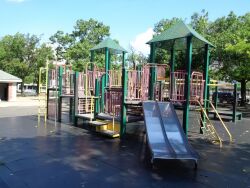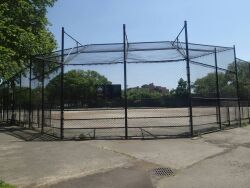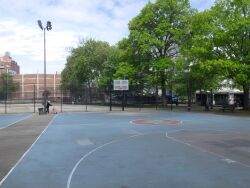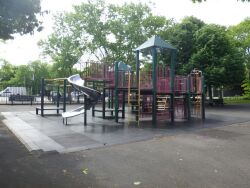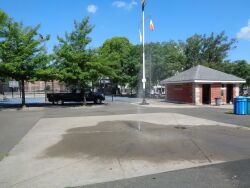Hoffman Park
Hoffman Park
What was here before?
A Quaker meeting house was built on this site in 1722. The meeting house was sold in 1760, serving as a private residence until it was destroyed in a fire in 1844. Another house was built on the site, which passed through several families. By the 1920s, the site was still sparsely populated though additional houses had been built.
How did this site become a park?
Parks acquired this property through condemnation in 1949. A portion of the park was used for the construction of the Long Island Expressway in 1953. This playground, and three others along the Long Island Expressway opened in May 1957.
Hoffman Playground was renovated in 1986 and 2025. The most recent redesign included a multipurpose play area surrounded by a walking and jogging track, an adult fitness area, two basketball courts, ping pong tables, multiple sitting areas, a playground and spray shower, and game tables.
Who is this park named for?
This park shares its name with Hoffman Drive, which borders the site, as well as the defunct Hoffman Boulevard. This major thoroughfare was renamed Queens Boulevard in 1916. Both roadways were named for John Thompson Hoffman (1828-1888), a career politician who served as both Mayor of New York City (1866-68) and Governor of New York (1869-73).
Born January 10, 1828, in the Village of Sing Sing, New York (later called Ossining), Hoffman graduated from Union College in 1846. Returning to Sing Sing to study law, he was admitted to the New York State Bar in 1849 and joined a law practice with Samuel Woodruff and Judge William M. Leonard. A member of the Young Men’s Tammany Hall General Committee, Hoffman was a candidate for United States District Attorney during President James Buchanan’s (1791-1868) administration. Buchanan decided, however, that Hoffman was too young and inexperienced.
In 1860, Hoffman was elected to the position of Recorder. His skillful handling of the 1863 Draft Riot participants ensured Hoffman both Republican and Democrat support as well as reelection later that fall. In 1865, with political assistance from Tammany Hall, the dominant City political institution of the time, he was elected Mayor of New York. Defeated for the governorship of New York in 1867, Hoffman was reelected Mayor that same year.
In 1868, Hoffman was elected New York State Governor through the dubious methods of William “Boss” Tweed (1823-1878) and his cronies at Tammany Hall, secretly hoping Hoffman might eventually win the United States presidency. However, with allegations of grand-scale corruption circling in 1871, public support began to wane for the Tammany Machine. Hoffman’s presidential aspirations evaporated soon thereafter. Hoffman died of heart disease in Wiesbaden, Germany on March 24, 1888.
Check out your park's Vital Signs
Clean & Safe
Green & Resilient
Empowered & Engaged Users
Share your feedback or learn more about how this park is part of a
Vital Park System

